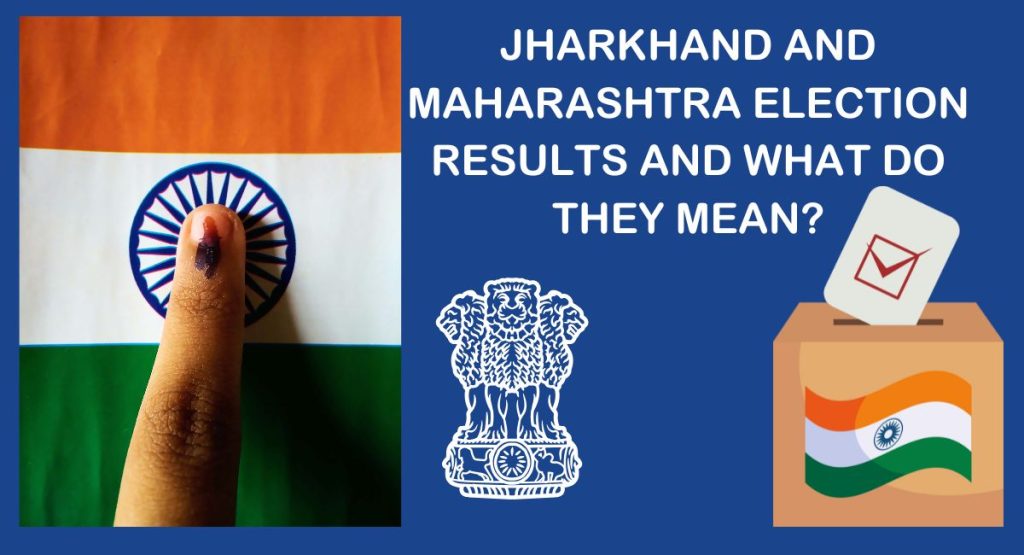Recent elections in Maharashtra and Jharkhand, held on November 20, 2024, have awakened significant interest and speculation across India’s political landscape. As the vote counting resumed on November 23, the picture began to depict some crucial observations about the voting sentiment and the present political atmosphere. The elections are significant because they not only reflect the voters’ short-term preferences but also influence the eventual political scenario that will take place in the country.

Maharashtra is the richest state in India and a political heartland. Elections here always translate to a battleground for competing ideologies and alliances, and election results often herald national trends. Jharkhand is different; the distinctive socio-economic challenges and the percentage of tribal population present their unique narrative that could shape regional politics and governance.
We will evaluate the election outcomes in both states, drawing special attention to the performance of key political parties and alliances. The article will outline how the results might shape national politics: strategies of the ruling party and opposition reactions. We will examine the voter turnout, key constituencies, and emerging trends to be able to say decisively what these results mean for India’s democracy.
Maharashtra Elections
The 2024 Maharashtra elections were significant not only for the state but India’s broader political landscape. Voting took place on November 20 and results drew considerable attention as barometers of the strength of various political alliances in a state known for its complex electoral dynamics.
The Maharashtra state reported a voter turnout of 67.59%, demonstrating high interest from the masses. This is because the electorate manifests active participation in democratic processes in a state where political loyalties swing between two elections.
The election saw two major alliances:
Mahayuti: This alliance had BJP, Shiv Sena, and NCP. With Chief Minister Eknath Shinde at the helm, the alliance was looking to consolidate the Hindu votes and emphasized governance record and development agenda.
Maha Vikas Aghadi (MVA): This coalition brought together Shiv Sena (Uddhav Balasaheb Thackeray faction), the Congress, and Sharad Pawar-led NCP. The MVA, which emphasized social justice, farmer welfare, and regional development, was also seeking to represent a more representative group of voters: minorities and the marginalized.
Maharashtra Assembly Election Results on November 2024 reflect the majority lead taken by Bharatiya Janata Party, a result for 132 seats; it is the highest number. Shiv Sena (SHS) ranks second, with 57 seats, followed by Nationalist Congress Party (NCP), having gained 41 seats.
The Shiv Sena (Uddhav Balasaheb Thackeray faction) won 20 seats, and the Indian National Congress secured 16 seats. The Nationalist Congress Party (Sharad Pawar faction) secured 10 seats, while the Samajwadi Party and All India Majlis-e-Ittehadul Muslimeen secured 2 seats each. Independents and other small parties together secured 11 seats.
This result indicates the BJP’s stronghold on the state of Maharashtra, with some regional and national parties also featuring in significant performance. The map visualization features the geographical distribution of party victories throughout Maharashtra.
Jharkhand Election
The Jharkhand elections were conducted simultaneously with those in Maharashtra and thus represented another crucial platform for parties to make a mark in a state strongly influenced by tribal populations and socio-economic challenges.
The political scenario of Jharkhand has been characterized by changing loyalties and local issues. The main contest was between:
NDA (National Democratic Alliance): Under the BJP, this alliance focused on development and infrastructure projects as the essence for retaining power.
Hemant Soren-led Alliance: Backed by regional parties, JMM allied under Hemant Soren, focusing mainly on tribal rights, land reforms, and local governance to counter the BJP. The Jharkhand Assembly election results show that the Jharkhand Mukti Morcha (JMM) is ahead with a clear margin of victory to emerge as the majority party with 34 seats. The Bharatiya Janata Party (BJP) got 21 seats and hence emerged as the main opposition. Indian National Congress a part of a major opposition bloc, came with 16 seats.
The Rashtriya Janata Dal (RJD) did well to win 4 seats, proving that it still enjoys strong popularity in some pockets. At the same time, the Communist Party of India (Marxist-Leninist) Liberation [CPI(ML)(L)] captured 2 seats, testifying to their local power base. AJSU Party (AJSUP), Lok Janshakti Party (Ram Vilas) [LJPRV], Jharkhand Loktantrik Krantikari Morcha (JJKM), and the Janata Dal (United) [JD(U)] each managed to bag 1 seat, indicating that fragmentation characterizes the political scene of Jharkhand.
The results point to the complex socio-political undercurrents in Jharkhand, where the JMM’s focus on tribal rights and local governance has struck a very responsive chord among voters. The BJP’s 22 seats reflect its hold on the state but also highlight the challenges in sustaining that dominance against regional coalitions. The INC and other regional parties may have fewer counts in the tally, but they are significant influencers of the political equations in the state.
Political Implications
The wins in Maharashtra and Jharkhand both symbolize a strong affirmation of the policies and governance style of the BJP. Having reached a majority in Maharashtra strikes a strong chord for Prime Minister Narendra Modi’s leadership, boding well for future elections at both state and national levels.
Strategic Insights about the Indian Elections 2024
The BJP’s emphasis on infrastructure development and economic growth appears to have resonated with voters. Moving forward, maintaining this focus will be crucial for sustaining voter support.
The success of the Mahayuti suggests that strategic alliances will remain essential for electoral success. The party may look to solidify these partnerships further to enhance its political capital.
The disappointing performance of MVA in Maharashtra raises significant questions regarding its electoral strategy and cohesion. With internal rifts becoming more pronounced-between factions of Shiv Sena and NCP-remains imperative to reevaluate.
The MVA needs to work diligently on rebuilding trust at the voter level. This involves negating governance failures during their previous tenure and presenting a clear vision for future policies.
Internal strength in this election, among opposition parties, will be as important as anything else. A divided opposition does not make for a potent opposition in any election.
In Jharkhand, the JMM has consolidated its position and does not seem to face much overt threat from the NDA. The focus here would again be on dealing with local issues successfully and making sure voters remain loyal.
Elation and a sea of joy covered social media and news outlets as the election results began to flow in. The BJP supporters were jubilant, happy over this victory, claiming that it has vindicated their governance model and their economics. Rallies were called in different parts of Maharashtra in this electoral triumph.
Alternatively, reactions from opposition leaders were characterized by disappointment and calls for introspection. Uddhav Thackeray’s Shiv Sena faction worried about losing ground despite their efforts to unite various voter bases under the MVA banner. Thackeray said the opposition parties needed to learn to be united moving forward.
Victory of Hemant Soren’s supporters in Jharkhand was viewed as a victory for tribal rights and proximal governance; Hemant Soren on his part addressed the public promising more emphasis on development projects targeted for marginalized sections.
Public mood suggests that despite the obvious victory for the ruling party, there still exists an undertone of frustration regarding issues that include unemployment and inflation, which would define future electoral strategies across all parties. As we conclude this analysis of the election results, it is clear that they carry wide implications not only for state politics but also for the entire political landscape of India as we move toward future elections.
Expected Changes in Maharashtra and Jharkhand
With the election results recently declared, significant changes may be anticipated in both Maharashtra and Jharkhand with the ruling parties becoming manifest through their implemented promises and plans. The BJP-led Mahayuti alliance in Maharashtra and the JMM-led coalition in Jharkhand are likely to embark on different developmental and governance initiatives that would unveil their electoral promises towards enhancing the socio-economic scenario of their state.
Changes in Maharashtra
The Mahayuti alliance having a decisive majority, Chief Minister Eknath Shinde has reiterated his commitment to continued infrastructure development as a core constituent of his administration’s agenda. The government will focus on urbanization projects, expand public transportation, and housing schemes for better living in the metropolitan cities of Mumbai and Pune. There will be a focus on improving rural connectivity through better roads and transportation facilities, therefore ensuring that rural populations have access to essential services.
Economic development programs will also be to the fore of the Mahayuti government. The government will ensure both domestic and foreign investment, by improving the environment in which businesses can operate, with benefits and easier rules. The people can expect an increase in employment opportunities in various sectors. Encouragement of small and medium enterprises will also be encouraged, including financial aid and training for local businesses to boost the entire business.
This government will likely expand more social welfare programs for vulnerable demographics. Support to farmers through subsidies and crop insurance schemes is also to continue since Maharashtra has an agrarian economy. Initiatives for women empowerment programs will also begin, with emphasis on engaging women in more work and making education and healthcare available to them.
Governance reforms are another key area of focus for Eknath Shinde’s administration. The government has pledged to combat corruption by enhancing transparency and accountability within public operations. This includes implementing measures such as the Maharashtra Right to Information Act, which aims to ensure citizens can access information about government activities. Moreover, there will be increased efforts to engage with citizens through public forums, allowing for direct feedback on policies and initiatives.
Changes in Jharkhand
In Jharkhand, the JMM-led coalition headed by Hemant Soren will focus its governance on rights and development of tribals. For most years of its existence, JMM has trumpeted the cause of rights for tribal communities. Reinforced through this election victory, a government will strengthen the protection of tribal land against encroachment and ensure control by local communities of their natural resources.
Other important determinants of Jharkhand’s future would include its strategies of economic development. The mining industry and sector are likely to be regulated by the JMM government in a better manner, from the local perspective, compared with environmental impacts. Skill development programs will also be initiated to enhance the employability level of youths, primarily in rural areas where employment opportunities are few.
Healthcare improvements are another priority for Hemant Soren’s administration. Plans are likely to include expanding healthcare facilities in rural areas to provide better access to medical services for underserved populations. Public health campaigns addressing maternal health and communicable diseases will also receive increased investment.
Education reforms shall form the backbone of the strategy for empowerment of communities at the hands of JMM. Investments in school infrastructure in rural areas will be part of the process so that students may have better learning environments. There will also be scholarship programs initiated to encourage higher education among the tribal students, spreading educational achievements in the community.
Conclusion
Now that Maharashtra and Jharkhand have both started their journeys on the paths of their respective ruling parties, it will be interesting to watch the fulfillment of these promises by the voters. Success in these ventures will not only determine the immediate socio-economic political scenario but will also determine the future electoral outcomes when the citizens can measure governmental effectiveness in their own lives. The coming years are critical because these governments will be required to deliver on their commitments while still weighing up challenges inherent in governance and development.
At ixamBee, we specialize in providing comprehensive online courses for government exams and online courses for government jobs. Our expertly designed courses for government jobs cater to a wide range of upcoming government exams. Whether you’re preparing for specific courses for government exams or seeking general guidance, ixamBee offers the resources like Beepedia previous year papers, SSC CGL, SSC CHSL, SSC MTS and other mock tests to succeed in exams like RBI Grade B, SEBI Grade A, NABARD Grade A, RRB NTPC, SSC MTS, NIACL Assistant, and more.
Also Read:
List of Wildlife Sanctuaries in India: Discover Nature’s Hidden Gems
Everything You Need to Know About SIDBI
How Can I Prepare for the FCI Exam Without Coaching?














